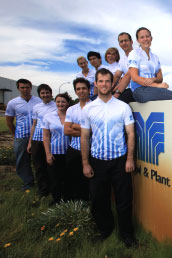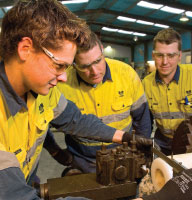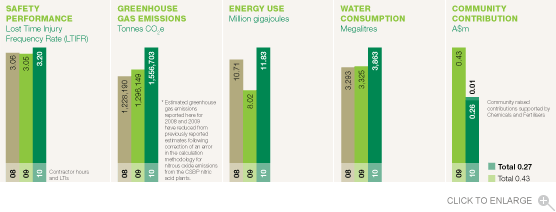About our business
The Chemicals and Fertilisers division of Wesfarmers, incorporates CSBP, Australian Vinyls (AV), ModWood and Australian Gold Reagents (AGR, a 75 per cent owned joint venture we operate).
We manufacture and supply chemicals, fertilisers, polyvinyl chloride (PVC or vinyl) resins and related services to the mining, agricultural and industrial sectors.
While the majority of our products are supplied to the domestic market, some of our products are also exported to the international market.
We operate a major industrial complex at Kwinana in WA and have complementary facilities in regional WA. Our business in WA produces agricultural fertilisers, ammonia, ammonium nitrate, sodium cyanide and other industrial chemicals.
AV and ModWood are located in Vic and manufacture and supply PVC resins and wood-plastic composite products.
We have a 50 per cent interest in Queensland Nitrates (QNP), an integrated ammonia/ammonium nitrate facility in Qld. QNP is not included in this report because we do not operate this business.
In this report, CSBP WA refers to CSBP operations in WA, including AGR, and excludes our Victorian-based businesses Australian Vinyls and ModWood.
As at 30 June 2010, we employed 765 people.

Year in review
Our focus continues to be the safe operation of our facilities in a way that minimises any adverse impact on our employees, the environment or the communities in which we operate.
During 2009/10, 14 work place injuries were recorded, an improvement on the 23 WPIs recorded in 2008/09. This was reflected in a reduction in the WPIFR from 11.7 in 2008/09 to 7.4 in 2009/10. There was an increased focus on safety communication which saw monthly team safety meetings increase from 254 meetings held in 2008/09 to 454 meetings held in 2009/10.
AV’s $5.3 million water recycling plant at Laverton was officially opened in February 2010 by the Victorian Premier. The project was part-funded by the Victorian government which contributed $1.8 million.
Our total water consumption at CSBP was 3,863 megalitres, up 16 per cent on last year while our net energy consumption was 11.83 million gigajoules, up 48 per cent on last year. Water and energy consumption increased as a result of increased production at our Kwinana site which returned to more normal levels following impacts from the Varanus Island gas disruption in 2008/09.
In 2009/10 we had 19 reportable environmental events, a decrease of eight on last year. Of these, 19 reportable events, six were potential non-compliances.
2010/2011 Priorities/Outcomes
| 2010 Priorities | Outcomes | Status | 2011 Priorities |
|---|---|---|---|
| Maximise use of recycled and reclaimed water supply sources | We increased our use of treated wastewater from the Kwinana Water Reclamation Plant (KWRP) at our Kwinana site. 85,471 kilolitres of recycled water was used in place of potable water following commissioning of the AV water recycling plant. |
|
|
| Reduce contaminant emissions to air and water | Metals in wastewater discharged to the licensed discharge point from our Kwinana site decreased from 104.9 kilograms in 2008/09 to 46.4 kilograms in 2009/10. Nitrogen load in wastewater discharged increased from 37.9 tonnes in 2008/09 to 44.7 tonnes 2009/10. Ammonium nitrate particulate emissions to air from our Kwinana site decreased from 41 tonnes in 2008/09 to 1.9 tonnes in 2009/10. |
||
| Improve workplace safety, control security and risk, and minimise injury | Lost Time Injury Frequency Rate (LTI FR) of 3.2 and a reduced Workplace Injury Frequency Rate (WPIFR) rate of 7.4. Lost Time Injuries (LTIs) remained at six. There was a decrease in losses associated with security breaches, and an increase in the reporting of minor security breaches. |
||
| Continue to develop a skilled and engaged workforce | $2.178 million spent on training and development. Three leadership courses completed, and another commenced. |
||
| Operate our manufacturing and storage facilities to high standards of process safety | For the two MHFs in WA, one operates to a safety report approved in accordance with the Dangerous Goods Safety Regulations 2007 and for the other we are working towards amending the existing safety report by the compliance date of 1 February 2011, which has been set in agreement with the Department of Mines and Petroleum. All WA MHFs and non-MHFs have current Dangerous Goods site licences, and AV has a MHF licence issued by WorkSafe Victoria. Continuation of internal process safety auditing for WA and AV MHFs. |
||
| Continue to improve and review our products, processes and services | CSBP business improvement model developed and endorsed. Standard operating procedures completed for the sodium cyanide business. Trials of a low-phosphorus turf product conducted and field trials of low water-soluble phosphorus product continued by CSBP Fertilisers. AV’s $5.3 million water recycling plant officially opened. Introduction of a new specialty product, chlorinated polyethylene, by AV. |
||
| Continue to contribute to and engage with the communities in which we operate | Community support activities continued. Membership and participation in key Kwinana Industries Council (KIC) committees continued. CSBP representatives attended KIC’s Community and Industries Forum meetings, and stakeholder forums and site tours were held at our Kwinana site. AV community engagement continued through our community group, the Environment Monitoring Team. AV is a member of the City West Water Community Liaison Committee and an observer of the Altona Complex Neighbourhood Consultative Group. |
KEY
![]() Achieved
Achieved
![]() Partially achieved
Partially achieved
![]() Not achieved
Not achieved
Performance charts
People
As at 30 June 2010 we employed 765 people, excluding contractors but including casual employees.
We remain committed to training and developing our employees to retain and maintain a skilled workforce. In 2009/10 we recorded an approximate spend of $2.178 million on training and development.
The company supported nine apprenticeships during the year.
During 2009/10 there were six LTIs, the same as in 2008/09. There were 14 WPIs, down significantly from the 23 WPIs in 2008/09.
Safety statistics are distributed and discussed by management each month and reported to our Board every three months.
Performance against our safety targets showed an increase in hazard and housekeeping inspections and permit to work audits due to an increased focus on hazard identification and compliance to the work permit system.
A team was formed to review the various task and behavioural observation systems used across CSBP. The team made various recommendations including the development of a safety observation card that was implemented in April 2010.
In 2010 we celebrated a century of manufacturing operations in WA with our employees at events in WA and Vic.
We continued work to address our six priority areas for improvement that resulted from our last employee opinion survey in September 2008. We also continued to provide information about our business to our employees and encourage feedback through our intranet, internal newsletters and employee briefings.

We supported our employees to participate in the Rebel Sport City to Surf for Activ and the Freeway Bike Hike for Asthma in WA.
Employees from our Soil and Plant Analysis Laboratory in their commemorative 100-year CSBP cycling jerseys for the HBF Freeway Bike Hike WA.
Environment
The first six months of operation of AV’s water recycling plant achieved a reduction in potable water consumption of 25 per cent compared to the same time period for the previous year.
We completed active remediation at our Bayswater site in November 2009. We are continuing to monitor water quality.

Victorian Premier John Brumby opened Australian Vinyl’s water recycling plant in February 2010.
Carbon and energy
Greenhouse emissions
Our greenhouse gas emissions (as reported under the National Greenhouse and Energy Reporting Act 2007) were estimated to be 1,475,588 tonnes of carbon dioxide equivalent (CO2e) and this equates to 0.7 tonnes of CO2e per tonne of product.
Greenhouse gas emissions were largely due to the Kwinana nitric acid plants (68 per cent), ammonia plant (22 per cent) and sodium cyanide plants (two per cent), and AV’s Laverton PVC plant (four per cent). In addition, Scope 3 emissions associated with our electricity, natural gas, transport fuel consumption, waste, and air travel were estimated to be 68,043 tonnes CO2e.
Energy use
Energy consumption was estimated to be 11.83 million gigajoules, up 48 per cent on last year. Net energy consumption per tonne of production was 5.3 gigajoules. This energy use is represented by natural gas (97.2 per cent), electricity (2.1 per cent) and other energy (0.8 per cent).
Energy use during the year related primarily to ammonia and sodium cyanide production which increased to return to more normal levels following impacts from the Varanus Island gas disruption in 2008/09.
Governance
Our people and compliance team and the AV sustainability team provided guidance and advice to the business on current and changing legislative and public policy requirements and support the business in complying with these requirements.
Our ammonium nitrate, ammonia, sodium cyanide and PVC resin facilities are classified as MHFs and all have the current approvals to operate.
We are not aware of any non-compliance during the year with licensing or approval conditions or other requirements, except as set out below.
During the year, we notified the Department of Environment and Conservation (DEC) in WA of 14 reportable events under the Environmental Protection Act 1986 (WA) and EPA Victoria of five reportable events under the Environment Protection Act 1970 (Vic).
Of the 19 reportable events, six were potential non-compliances, while 13 incurred no potential enforcement action. Of these, five related to a reportable threshold (between 75 and 100 per cent of the relevant licence limit) and eight related to licence targets.
The potential non-compliances were:
- The accuracy and reliability of data collected for a sodium cyanide liquid production plant NOx analyser at Kwinana for February was below licence requirement.
- Three incidents related to exceeding the licence limit for vinyl chloride monomer for a stack emission point at AV.
- Discharge to sewer above agreement limit at AV.
- A broken air line at the incinerator sample point at AV.
The DEC has responded to incidents covered in previous sustainability reports as follows:
- A letter advising that no further action will be taken regarding the discharge of wastewater to ground from the no.2 prill plant wastewater storage pond as reported in 2009.
- A formal letter of warning regarding the incident we reported in 2009 where the no.1 nitric acid plant NOx analyser did not read correctly during start-up.
- A letter advising of their concern regarding the incident where the maximum half-hourly NOx concentration exceeded the licence limit during a start-up as reported in 2009. It recommended preventative actions and advised that no further action would be taken.
- A formal letter of warning in relation to the incident where we failed to collect a continuous sample from the effluent stream discharged to the Sepia Depression Ocean Outlet Landline (SDOOL) as reported in 2009.
Nine potential non-compliances reported in previous sustainability reports are still awaiting resolution by either the DEC in WA or EPA Victoria.
As reported last year, we have potential industry-to-industry noise non-conformance on the northern and eastern boundaries of our Kwinana site.
WorkSafe WA issued one improvement notice to CSBP WA relating to dust within the granulation plant at Kwinana. This is being addressed by a series of plant modifications.
Community
We provided support to more than 130 organisations in 2009/10, either through direct financial support or through the donation of goods. In line with our sponsorship guidelines, this support was directed towards communities in which our businesses operate.
In addition to this, we supported our employees participation in the Rebel Sport City to Surf for Activ and the HBF Freeway Bike Hike for Asthma (both in WA) and Australia’s Biggest Morning Tea for the Cancer Council.
We continued our support of Youth Focus, a not-for-profit organisation in WA which assists young people at risk of suicide or self-harm.
We continued our membership and involvement with key industry bodies including the:
- Kwinana Industries Council
- Plastics and Chemicals Industries Association Inc
- Fertilizer Industry Federation of Australia
- Vinyl Council of Australia
- Australian Industry Group
Previously we have reported on our ongoing communications with interested parties about our importation of phosphate rock from the Boucraa region of Western Sahara.
In October 2009, we announced an investment of almost $5 million in a regenerative thermal oxidiser (RTO) to broaden phosphate rock supply options for our superphosphate manufacturing operation at Kwinana.
We had the following four complaints from an industry neighbour regarding odour from our Kwinana site:
- Ammonia odour detected, however no cause was identified.
- Two ammonia odour complaints related to a leak of ammonia gas which was identified in the ammonia compressors in liquefaction and subsequently repaired.
- Ammonia odour detected, with the source identified as venting waste gas in our sodium cyanide plant.
Economic investment
Our products and services are inputs into a variety of Australian industries including agriculture, iron ore and coal mining, nickel and gold extraction, and construction.
In 2009/10 our revenue was $1,059.8 million.
In November 2009 we announced the approval of a front-end engineering and design (FEED) study to increase ammonium nitrate production capacity at our Kwinana industrial complex.
The study will provide a detailed assessment of the construction of an additional nitric acid plant and ammonium nitrate plant, and an upgrade of the existing prilling plant at our Kwinana site.
AGR also continued its $15 million investment in the upgrade of its Kwinana sodium cyanide production plant at Kwinana to increase production to supply the new Boddington goldmine in WA.


